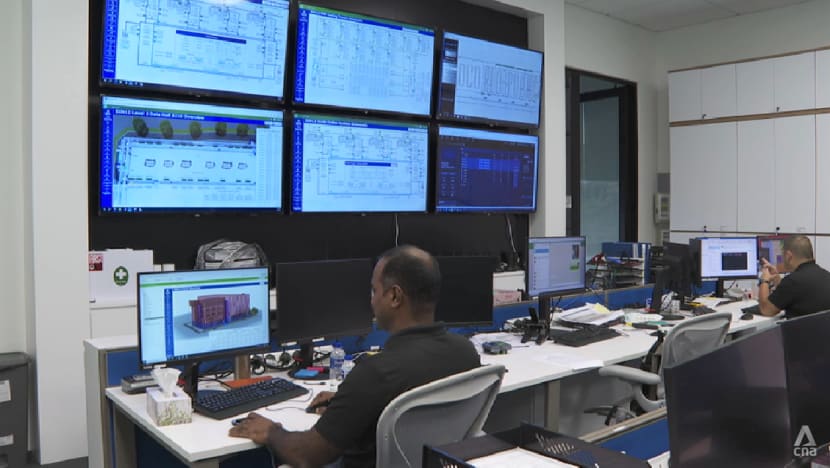Push to green data centres as they guzzle more power amid growing digital demands
While discussions about reducing greenhouse emissions often centre on manufacturing, agriculture and transport, the carbon footprint of data centres is also significant.

File photo of a data centre. (Photo: iStock/gorodenkoff)

This audio is generated by an AI tool.
SINGAPORE: The need for more places to store data amid growing digital demands – from streams of text messages to advanced technologies such as artificial intelligence – will require more energy, which could end up translating into more greenhouse gas emissions.
While discussions about reducing emissions often centre on manufacturing, agriculture and transport, the carbon footprint of data centres is also significant.
Estimates vary, but these facilities consume between 200 and 400 terawatt-hours (TWh) of electricity globally each year. According to the International Energy Agency (IEA), energy use has grown by 20 to 40 per cent annually over the past several years.
As a result, data centres account for about 1 per cent to up to 5 per cent of global greenhouse gas emissions, according to different reports. They also use vast amounts of water for cooling and create noise pollution.
TRUE IMPACT OF DATA CENTRES HARD TO GAUGE
However, the true impact of these facilities is hard to gauge, said observers.
“The collection and reporting of sustainability-related data and the calculation of related metrics is patchy at best,” said Mr Patrick Chan, vice president for Asia at digital infrastructure advisory organisation Uptime Institute.
“Many operators struggle to meet emerging sustainability of reporting requirements, along with the requirements of some customers and the public.”
Dr Steven Gonzalez Monserrate, a postdoctoral researcher at the Fixing Futures Research Training Group at Goethe University, added: “Most of the data centres of the world are not these giant, big tech kinds of data centres (seen) in many films.
“They're actually smaller in scale. They don't have the resources. They're not as high-tech or sophisticated. And as a result, they also don't have a lot of information or insight into their environmental impacts.”
Experts said the path to a more sustainable future requires better public awareness.
Singapore is among the countries working to transform data centres.
The nation hosts more than 70 of these facilities and its emphasis on sustainable growth and low carbon emissions makes it selective about building new ones.
This year, authorities set a standard as part of efforts to get data centre operators to gradually raise temperatures to 26 degrees Celsius and higher. Typically, some operators choose to keep their server rooms at temperatures of 22 degrees Celsius and below.
Last month, Singapore unveiled a data centre test bed aimed at developing energy-efficient cooling technologies customised for tropical environments.
Minister of State for Trade and Industry Alvin Tan said then that data centres support Singapore’s digital economy, adding: “That's critical. We cannot do without them, but we need to make them greener.”

‘EVERY LITTLE BIT COUNTS’
The view is shared by companies such as Empyrion DC, a next-generation digital infrastructure platform headquartered in Singapore.
Empyrion DC CEO Mark Fong said this involves thinking about sustainability holistically, “because every little bit counts”.
The company has taken steps to cut down its carbon footprint, including regularly upgrading technology, properly managing e-waste and reducing water usage in the bathrooms.
“The end goal is really to be able to tap off the grid clean energy,” said Mr Fong, adding that even starting with 10 per cent is a step in the right direction.
Tech giant Google has been matching 100 per cent of its global annual electricity consumption with purchases of renewable energy since 2017.
The company plans to operate its data centres around the world on carbon-free energy by 2030.
“Obviously this is very challenging, even with… the most advanced renewable markets that we have now,” said Mr Ken Siah, head of Data Center Public Affairs (Asia Pacific) at Google.
“The sun is not going to shine 24 hours a day. The wind is not going to blow 24 hours a day. So we have to really work with governments, energy producers, (and) renewable energy generators to make sure the grid is set up and properly equipped to make this transition.”
There is a need to encourage governments to tweak regulations, and invest in scores of renewable energy projects globally, said observers.
For Google, the transition also involves installing more efficient chips, using machine learning to slash power consumption, and even giving customers a chance to choose where in the world they want to run their cloud computing to meet their own sustainability goals.
“Customers are demanding it. Governments are demanding it. It is a business imperative that they have to become more sustainable,” said Mr Siah.
“And I think a lot of companies recognise this, and I think that's why you see there's a greater push in the industry in general to have more sustainable data centres.”
Related:
NEED TO RAISE AWARENESS
Researchers are also part of the push to have sustainable data centres.
A team at Nanyang Technological University (NTU), for instance, is using a non-conductive liquid to spray-cool central processing units (CPUs).
"So with this invention, there is no chiller-bay cooling system required to cool the data centre,” said Associate Professor Wong Teck Neng of NTU’s School of Mechanical and Aerospace Engineering.
“The only energy-demanding equipment will be the pump and the fan. So that results in 26 per cent savings in the total energy consumption and also 26 per cent in terms of carbon footprint.”
Dr Wong added that this technology could be scaled up to help cool data centres and a potential solution in wider efforts to confront the climate crisis.
“Sustainability and reducing carbon footprints is everyone’s responsibility right now,” he said.
“So this is a path that we all have to move towards, to design more innovative cooling solutions to help to solve all these grand challenges of global warming.”




















